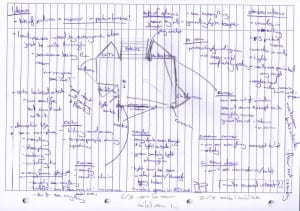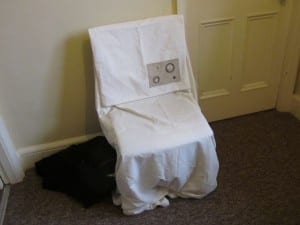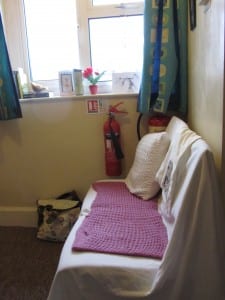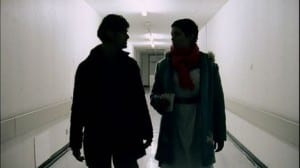Performance Process
First impressions
The house where we are doing our Site Specific performance and the home I grew up in have certain similarities so it was slightly unnerving walking up to the landing for the first time, as it felt strangely familiar, especially the layout of the upstairs rooms which sparked a lot of childhood memories.

Above: My landing observations. ((Pearson, Louise (2013) Landing Observations [Photograph]. ))
I spent some time exploring the landing in detail and recorded my observations from different positions in the room, intrigued to see how the changing perspectives influenced my perception of the space. I also quickly sketched the layout of the landing and added in ideas for performances that could be staged within this small area.
The thing that struck me most is that the landing is almost a non-place (it is not a room per se as it has no function other than as a place to pass through) which makes it feel terribly lonely. I toyed with idea of somehow making the landing into a real room, perhaps a room in miniature or like a small flat with bits from every room. This would give a purpose to the previously dead space whilst inverting the idea of what a landing should be.
The landing is also a gateway area for anyone walking up the stairs yet is not a place where people linger for long. Another idea could be to have a gatekeeper/guide at the top of the stairs who would direct the audience around the upstairs rooms or even give them a choice in where they want to go, by giving clues as to what is behind the closed doors.
I thought about using the nails in the walls to hang pictures or photographs to make the room more homely; these might be of our own or staged families. It would also be interesting to hang a mirror within a picture frame to encourage the audience to reflect on their own homes and families.
Above : Landing Panorama ((Pearson, Louise (2013) Landing Panorama [Photograph]. ))
The Landing
Leading on from my idea of turning the landing into a room, I decided to try decorating the space as if it was a living room to see firstly if there was enough space for any seating and secondly, to see whether it inspired any performance ideas. Luckily there was just enough room to create a make-shift sofa and chair though it did make moving around the landing awkward for the other performers.
I began to devise a narrative about the history of the house, as well as the etymology of words such as landing and stairs. I then considered the daily rituals which we perform without realising their significance. I was inspired by Edwin Heathcote’s The Meaning of Home (2012) where he talks about mini-rituals such as ‘opening the [front]door… welcomed in the sun and light of the new day’ ((Heathcote, E (2012) The Meaning of Home. London: Frances Lincoln. )) which led me to think about the daily rituals we all carry out, such as brushing our hair, which I know many people perform in the same order every day without thinking, and therefore ritualising it.
However, these ideas were short-lived as it felt wrong to try and disguise the landing as another room rather than explore its own features. I decided to scrap the living room idea, but I did still want to incorporate the rituals somehow.
Left: Chair ((Pearson, Louise (2013) Chair [Photograph]. ))
Right: Sofa side view ((Pearson, Louise (2013) Sofa side [Photograph]. ))
As a contrast to my first idea, I next removed all the extraneous objects from the landing and focused on the movement that occurs within the space and began creating a new performance concept. My plan was to get the audience to play a game, where they had to navigate around the landing only using parts of the floor which would never usually be stood on. In practise it was very difficult to explain the rules and aim of the game, especially in view of the small size of the landing, which would be very easy to cross.
I then began looking at ways of performing which required minimal movement; I played with the idea of rituals again, and sat in front of a mirror on the landing brushing my hair to see if it gave me any ideas. Performing different daily rituals came to mind, but unless I explained them, it didn’t make sense for me to be performing them on the landing; surely rituals such as brushing my hair would be done in the bedroom? So I turned to video art to see if that could produce the effect I wanted while not appearing out of place.
For the video I filmed half hour clips of myself performing a variety of ritualised activities, which I then played on my laptop but which could only be viewed through a mirror placed opposite it. The idea was that the video would become an installation piece set out so that when an audience member walks up the stairs they would first see themselves in the mirror and would then need to position themselves directly behind a monitor (which is playing my video) in order to see it through the mirror. I was inspired to display my video in this way by the film 33 x Around the Sun which is ‘a dreamlike journey into a world where nothing is quite what it seems’. ((Flamin (2005) 33 x Around the Sun, Available at: http://flamin.filmlondon.org.uk/showcase/assets/showcase_items/33_x_around_the_sun (Accessed: 9th May 2013). )) In one scene in a cafe, the beginning is filmed through a mirror, which is eventually revealed during the scene. The idea of not knowing whether a film clip is shot through a mirror or not fascinates me as it creates an Alice Through the Looking Glass perspective once it is revealed.
Above: An image from 33 x Around the Sun ((Hardwick, John (2005) Image of 33 x Around the Sun [Online]. Available at: http://flamin.filmlondon.org.uk/showcase/assets/showcase_items/33_x_around_the_sun (Accessed: 9th May 2013). ))
I was also inspired by Marina Abramovic’s The Artist is Present in which she sits unmoving across from a chair in which audience members may sit and share a moment of contemplation with her.
Above: Background information on Abramovic’s performance at MoMA. ((MoMAvideos (2010) Marina Abramović: Live at MoMA. Available at: http://www.youtube.com/watch?v=2GD5PBK_Bto (Accessed: 9th May 2013). ))
This inspired one clip of my rituals video in which I watch the camera for an extended period of time as a representation of daydreaming, where our eyes are often fixed on a distant point. Though the clips themselves worked well as an endurance piece of film, I believed they were too long for audience members to appreciate the aim of my piece. Consequently I cut my clips first down to 10 minute segments, then finally to a 12 minute complete video with 6 clips of around 2 minutes each, playing on an infinite loop. This meant that audience members who would only be on the landing for a short amount of time would be able to see at least two or three clips.
Stairs
My original idea for the stairs was to number each stair, and to have a fact on the wall which related to that number either to do with the house, the street or about our group of performers. Though this was interesting for some numbers, many of them were uninteresting facts merely acting as fillers.
I then moved on to researching stories involving stairs such as the Greek myth of Orpheus and Eurydice and the Biblical stories of Jacob’s Ladder and when the Queen of Sheba visits Solomon. Though none of these ideas led to any final performance ideas, I did use some of their aspects in my video performance. In both the Biblical and Ancient Greek stories there is a lyre or harp involved which led to the inspiration of my clay model. I also took influence from the ‘don’t look back’ aspect of Orpheus’ story as well as the Biblical tale of Lott’s wife, both of whom ignored the warnings given and turned to look back. In the clip inspired by Marina Abramovic, at the end I turn to see what’s behind me as a subtle indicator to my research into these ancient stories.
Toilet Room
My original idea for the toilet room was to create an anonymous open canvas upon which audience members could leave their messages and memories of home. I also prepared a list of questions that I would ask the other performers, about their ideas or memories of home. Though this did work well as an idea, it would have been time-consuming for all of the performers so I decided to focus on creating an installation through all of my own work.
After reading Georges Perec’s An Attempt at Exhausting a Place in Paris I was inspired to do my own observations of everyday life, which I would then stick up all over the toilet room walls. In this way I would bring the outside world into the private area of the toilet room, subverting the inward-thinking nature of the room.



